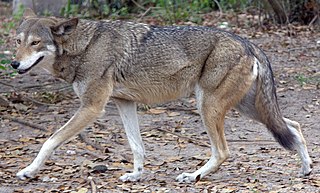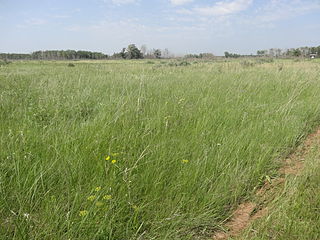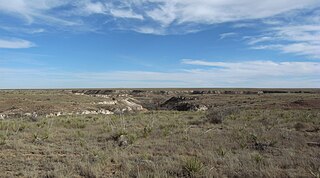
The coyote is a species of canine native to North America. It is smaller than its close relative, the wolf, and slightly smaller than the closely related eastern wolf and red wolf. It fills much of the same ecological niche as the golden jackal does in Eurasia. The coyote is larger and more predatory and was once referred to as the American jackal by a behavioral ecologist. Other historical names for the species include the prairie wolf and the brush wolf.

The red wolf is a canine native to the southeastern United States which has a reddish-tawny color to its fur. Morphologically it is intermediate between the coyote and gray wolf, and is very closely related to the eastern wolf of eastern Canada.

The American badger is a North American badger similar in appearance to the European badger, although not closely related. It is found in the western, central, and eastern United States, northern Mexico, and south-central Canada to certain areas of southwestern British Columbia.

Coywolf is an informal term for a canid hybrid descended from coyotes, eastern wolves and gray wolves. All members of the genus Canis are closely genetically related with 78 chromosomes and therefore can interbreed. One genetic study indicates that these two species genetically diverged relatively recently. Genomic studies indicate that nearly all North American gray wolf populations possess some degree of admixture with coyotes following a geographic cline, with the lowest levels occurring in Alaska, and the highest in Ontario and Quebec, as well as Atlantic Canada.
Canid hybrids are the result of interbreeding between different species of the "true dog" tribe Canini, specifically in the Canina subtribe of wolf-like canids. They often occur in the wild, in particular between domestic or feral dogs and wild native canids.

Crotalus viridis is a venomous pit viper species native to the western United States, southwestern Canada, and northern Mexico. Currently, two subspecies are recognized, including the nominate subspecies described here.

The Great Plains wolf, also known as the buffalo wolf or loafer, is an extinct subspecies of gray wolf with a distribution that once extended throughout the Great Plains from southern Manitoba and Saskatchewan southward to northern Texas. The subspecies was declared extinct in 1926. They were described as a large, light-colored wolf but with black and white varying between individual wolves, with some all white or all black. The Native Americans of North Dakota told of how only three of these wolves could bring down any sized bison.

Mearns' coyote is a subspecies of coyote native to the Southwestern United States. It is found in Nevada, Arizona, southern Utah, the deserts of southeastern California, west of Rio Grande in New Mexico, and extreme southwestern Colorado.

The Tamaulipan matorral is an ecoregion in the deserts and xeric shrublands biome on the eastern slopes of the Sierra Madre Oriental range in northeastern Mexico. It is a transitional ecoregion between the Tamaulipan mezquital and the Sierra Madre Oriental pine-oak forests to the west and the Veracruz moist forests to the south. It is a desert shrubland where the flora mainly consists of woody shrubs, small trees, cacti, and succulents. Piedmont scrub occurs in shallow hollows and montane chaparral occurs above about 1,700 m (5,600 ft). There are a number of resident bird species and the mammals include Mexican prairie dog, Saussure's shrew, yellow-faced pocket gopher, Allen's squirrel, collared peccary and coyote.

Canis lepophagus is an extinct species of canid which was endemic to much of North America during the Early Pliocene. It is notable because its lineage is proposed to have led to both wolves and coyotes.

The Northern tall grasslands is one of 867 terrestrial ecoregions defined by the World Wide Fund for Nature. This ecoregion largely follows the Red River Valley in the Canadian province of Manitoba and the American states of North Dakota and Minnesota.

The South Central Rockies forests is a temperate coniferous forest ecoregion of the United States located mainly in Wyoming, Idaho, and Montana. It has a considerably drier climate than the North Central Rockies forest.

The Western short grasslands is a temperate grassland ecoregion of the United States.

The eastern coyote is a wild North American canine hybrid with both coyote and wolf parentage. The hybridization likely first occurred in the Great Lakes region, as western coyotes moved east. It was first noticed during the early 1930s to the late 1940s, and likely originated in the aftermath of the extirpation of the gray wolf in southeastern Ontario, Labrador. and Quebec, thus allowing coyotes to colonize the former wolf ranges, and mix with the remnant wolf populations. This hybrid is smaller than the eastern wolf and holds smaller territories, but is larger and holds more extensive home ranges than the typical western coyote.

The northeastern coyote is a subspecies of coyote native to north-central Saskatchewan, Manitoba, southern Ontario, and extreme southern Quebec. Its population in the United States occurs along the eastern edge of North Dakota, Minnesota, Iowa, Missouri, Michigan, Wisconsin, Illinois, and northern Indiana. However, due to increased clearing of land for agriculture, the northeastern coyote has expanded its range throughout the entire state of Indiana. It is similar to C. l. latrans, or larger, but darker in color, and has a broader skull. The subspecies was first described by Hartley H. T. Jackson in 1949.

The Northern Mixed Grasslands is one of 867 terrestrial ecoregions defined by the World Wide Fund for Nature. This ecoregion includes parts of the Canadian provinces of Alberta, Saskatchewan, and Manitoba, north-central and eastern North Dakota, most of east South Dakota, and north-central Nebraska in the American Great Plains. The United States Environmental Protection Agency (EPA) defines this ecoregion as the Northern Glaciated Plains.

The Pleistocene coyote, also known as the Ice Age coyote, is an extinct subspecies of coyote that lived in western North America during the Late Pleistocene era. Most remains of the subspecies were found in southern California, though at least one was discovered in Idaho. It was part of a carnivore guild that included other canids like foxes, gray wolves, and dire wolves.
















